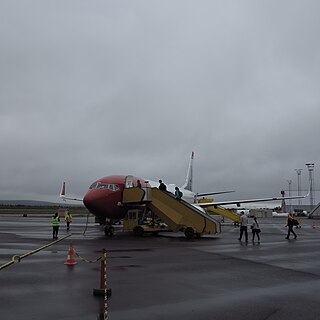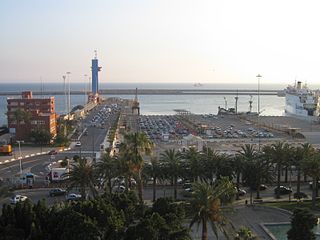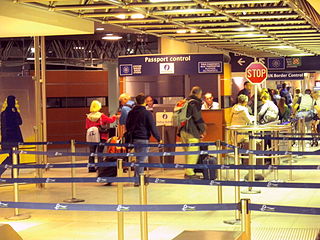
A cruise ship is a passenger ship used for pleasure voyages on which the voyage itself, the ship's amenities, and usually the different destinations along the way each form part of the passengers' experience. Transportation is usually not the main purpose of cruising, particularly on cruises that return passengers to their originating port. On "cruises to nowhere" or "nowhere voyages", cruise ships make two- to three-night round trips without visiting any ports of call.
Palsgraf v. Long Island Railroad Co., 248 N.Y. 339, 162 N.E. 99 (1928), is a leading case in American tort law on the question of liability to an unforeseeable plaintiff. The case was heard by the New York Court of Appeals, the highest state court in New York; its opinion was written by Chief Judge Benjamin Cardozo, a leading figure in the development of American common law and later a United States Supreme Court justice.

MS Mikhail Lermontov was an ocean liner owned by the Soviet Union's Baltic Shipping Company, built in 1972 by V.E.B. Mathias-Thesen Werft, Wismar, East Germany. It was later converted into a cruise ship. On 16 February 1986 she collided with rocks near Port Gore in the Marlborough Sounds, New Zealand, and sank, claiming the life of one of her crew members.

Baggage or luggage consists of bags, cases, and containers which hold a traveller's personal articles while the traveler is in transit. A modern traveller can be expected to have packages containing clothing, toiletries, small possessions, trip necessities. On the return trip, travellers may have souvenirs and gifts. For some people, luggage and the style thereof is representative of the owner's wealth and status. Luggage is constructed to protect the items during travel, either with a hard shell or a durable soft material. Luggage often has internal subdivisions or sections to aid in seecuring items. Handles are typically provided to facilitate carrying, and some luggage may have wheels and/or telescoping handles or leashes to make moving them easier.

MV Aurora is a cruise ship of the P&O Cruises fleet. The ship was built by Meyer Werft at their shipyard in Papenburg, Germany. At over 76,000 tonnes, Aurora is the smallest and oldest of six ships currently in service with P&O Cruises. She officially entered service with the company in April 2000 and was named by Anne, Princess Royal in Southampton, United Kingdom. Aurora was refitted in 2014, during which the ship is the first of P&O's ships to receive an updated British Union flag design on her bow and her funnel repainted from yellow to blue.

Costa Crociere S.p.A., operating as Costa Cruises, is an Italian cruise line founded in 1854 and organized as a wholly owned subsidiary of Carnival Corporation & plc since 2000. Based in Genoa, Italy, the cruise line primarily caters to the Italian cruise market, but the company's fourteen ships, which all sail under the Italian flag, provides itineraries sailing to countries globally.

The Port of Kaohsiung is the largest harbor in Taiwan, handling approximately 10.26 million twenty-foot equivalent units (TEU) worth of cargo in 2015. The port is located in southern Taiwan, adjacent to Kaohsiung City, and surrounded by the city districts of Gushan, Yancheng, Lingya, Cianjhen, Siaogang, as well as Cijin. It is operated by Taiwan International Ports Corporation, Taiwan's state-owned harbor management company.

A sea captain, ship's captain, captain, master, or shipmaster, is a high-grade licensed mariner who holds ultimate command and responsibility of a merchant vessel. The captain is responsible for the safe and efficient operation of the ship—including its seaworthiness, safety and security, cargo operations, navigation, crew management, and legal compliance—and for the persons and cargo on board.

The New York Port of Embarkation (NYPOE) was a United States Army command responsible for the movement of troops and supplies from the United States to overseas commands. The command had facilities in New York and New Jersey, roughly covering the extent of today's Port of New York and New Jersey, as well as ports in other cities as sub-ports under its direct command. During World War I, when it was originally known as the Hoboken Port of Embarkation with headquarters in seized Hamburg America Line facilities in Hoboken, New Jersey, the Quartermaster Corps had responsibility. The sub-ports were at Boston, Baltimore, Philadelphia and the Canadian ports of Halifax, Montreal and St. Johns. The World War I port of embarkation was disestablished, seized and requisitioned facilities returned or sold and operations consolidated at the new army terminal in Brooklyn. Between the wars reduced operations continued the core concepts of a port of embarkation and as the home port of Atlantic army ships. With war in Europe the army revived the formal New York Port of Embarkation command with the New York port, the only Atlantic port of embarkation, taking a lead in developing concepts for operations.

Boarding is the entry of passengers onto a vehicle, usually in public transportation. Boarding starts with entering the vehicle and ends with the seating of each passenger and closure of the doors. The term is used in road, water and air transport.

Airport check-in is the process whereby passengers are accepted by an airline at the airport prior to travel. The airlines typically use service counters found at airports. The check-in is normally handled by an airline itself or a handling agent working on behalf of an airline. Passengers usually hand over any baggage that they do not wish or are not allowed to carry in to the aircraft's cabin and receive a boarding pass before they can proceed to board their aircraft.

The MV Queenscliff is a double ended roll-on/roll-off vehicle ferry owned by Peninsula Searoad Transport of Victoria, Australia. It has operated between the heads of Port Phillip Bay between the towns of Queenscliff and Sorrento since December 1993. The ferry replaced the earlier Peninsula Princess used on the route, and can carry approximately 80 vehicles and 700 passengers. During the 2011 off season the ferry underwent a $2 Million refit.

The MV Sorrento is a double ended roll-on/roll-off vehicle ferry owned by Peninsula Searoad Transport of Victoria, Australia. It has operated between the heads of Port Phillip Bay between the towns of Queenscliff and Sorrento since 2000. It is the sister ship of MV Queenscliff, and on entering service enabled a doubling in the service frequency across the bay. The ferry can carry approximately 80 vehicles and 700 passengers.

The Marina Bay Cruise Centre Singapore is a cruise terminal in Singapore, located at Marina South. The construction of the S$500 million terminal began in October 2009 and was completed on 22 May 2012. It received its first ship, the Voyager of the Seas, on 26 May 2012. The official opening ceremony of MBCCS was on 22 October 2012.
A departure card, also known as an outgoing passenger card or embarkation card, is a legal document used by immigration authorities to provide passenger identification and an effective record of a person’s departure from certain countries. It also serves as a declaration in relation to health and character requirements for non-citizens entering a particular country. The departure card can come attached with its corresponding arrival card with the former being retained in the passport after passport control clearance. The card is then surrendered to passport control upon departure.

The Port of Almeria is a busy ferry-port in Almeria, Spain.

A repositioning cruise is a cruise in which the embarkation port and the disembarkation port are different. This is a less common type of cruise; in the majority of cruises the ship's final destination is the same as the starting point.
A cruise ship ID card is a plastic card the size of a credit card that serves several functions for passengers on a cruise ship. Cruise ship ID cards are scanned at the entrances to the ship and at various points throughout the ship, either via magnetic strip, RFID readers or bar code in order to identify the passenger, allow entry to and exit off the ship, allow entry into certain areas of the ship, including the passenger's cabin, bill purchases to the passenger, and various other functions.

Juxtaposed controls are an arrangement between Belgium, France and the United Kingdom whereby border control on certain cross-Channel routes take place before boarding the train or ferry, rather than upon arrival after disembarkation. With the exception of the Eurotunnel route, customs checks remain unaffected by juxtaposed immigration controls and continue to take place upon arrival after disembarkation.
A manifest, customs manifest or cargo document is a document listing the cargo, passengers, and crew of a ship, aircraft, or vehicle, for the use of customs and other officials. Where such a list is limited to identifying passengers, it is a passenger manifest or passenger list; conversely, a list limited to identifying cargo is a cargo manifest or cargo list. The manifest may be used by people having an interest in the transport to ensure that passengers and cargo listed as having been placed on board the transport at the beginning of its passage continue to be on board when it arrives at its destination.
This document, made up generally by the ship's broker, from the contents of the bills of lading, contains a specification of the nature and quantity of the cargo laden, and is generally attested officially, and in some countries notarially. The prize laws seldom mention this paper ; nor is it general ; but yet of essential importance in case of search, as well for belligerents, as for neutrals in procuring a speedy dismissal. It is usual to require it at the custom house.
















